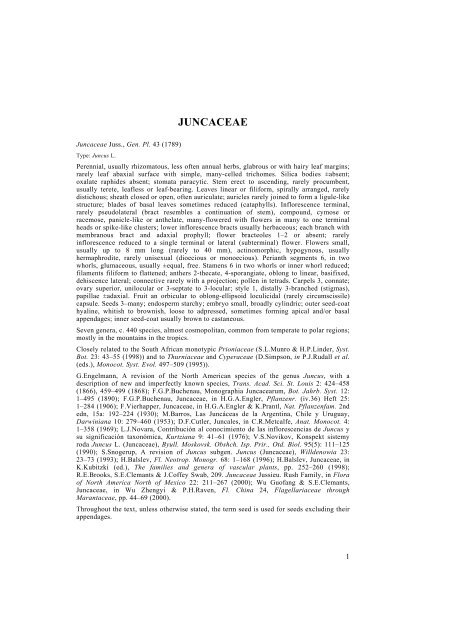Part 6. JUNCACEAE 1: Rostkovia to Luzula - Species Plantarum ...
Part 6. JUNCACEAE 1: Rostkovia to Luzula - Species Plantarum ...
Part 6. JUNCACEAE 1: Rostkovia to Luzula - Species Plantarum ...
You also want an ePaper? Increase the reach of your titles
YUMPU automatically turns print PDFs into web optimized ePapers that Google loves.
Juncaceae Juss., Gen. Pl. 43 (1789)<br />
Type: Juncus L.<br />
<strong>JUNCACEAE</strong><br />
Perennial, usually rhizoma<strong>to</strong>us, less often annual herbs, glabrous or with hairy leaf margins;<br />
rarely leaf abaxial surface with simple, many-celled trichomes. Silica bodies ±absent;<br />
oxalate raphides absent; s<strong>to</strong>mata paracytic. Stem erect <strong>to</strong> ascending, rarely procumbent,<br />
usually terete, leafless or leaf-bearing. Leaves linear or filiform, spirally arranged, rarely<br />
distichous; sheath closed or open, often auriculate; auricles rarely joined <strong>to</strong> form a ligule-like<br />
structure; blades of basal leaves sometimes reduced (cataphylls). Inflorescence terminal,<br />
rarely pseudolateral (bract resembles a continuation of stem), compound, cymose or<br />
racemose, panicle-like or anthelate, many-flowered with flowers in many <strong>to</strong> one terminal<br />
heads or spike-like clusters; lower inflorescence bracts usually herbaceous; each branch with<br />
membranous bract and adaxial prophyll; flower bracteoles 1–2 or absent; rarely<br />
inflorescence reduced <strong>to</strong> a single terminal or lateral (subterminal) flower. Flowers small,<br />
usually up <strong>to</strong> 8 mm long (rarely <strong>to</strong> 40 mm), actinomorphic, hypogynous, usually<br />
hermaphrodite, rarely unisexual (dioecious or monoecious). Perianth segments 6, in two<br />
whorls, glumaceous, usually ±equal, free. Stamens 6 in two whorls or inner whorl reduced;<br />
filaments filiform <strong>to</strong> flattened; anthers 2-thecate, 4-sporangiate, oblong <strong>to</strong> linear, basifixed,<br />
dehiscence lateral; connective rarely with a projection; pollen in tetrads. Carpels 3, connate;<br />
ovary superior, unilocular or 3-septate <strong>to</strong> 3-locular; style 1, distally 3-branched (stigmas),<br />
papillae ±adaxial. Fruit an orbicular <strong>to</strong> oblong-ellipsoid loculicidal (rarely circumscissile)<br />
capsule. Seeds 3–many; endosperm starchy; embryo small, broadly cylindric; outer seed-coat<br />
hyaline, whitish <strong>to</strong> brownish, loose <strong>to</strong> adpressed, sometimes forming apical and/or basal<br />
appendages; inner seed-coat usually brown <strong>to</strong> castaneous.<br />
Seven genera, c. 440 species, almost cosmopolitan, common from temperate <strong>to</strong> polar regions;<br />
mostly in the mountains in the tropics.<br />
Closely related <strong>to</strong> the South African monotypic Prioniaceae (S.L.Munro & H.P.Linder, Syst.<br />
Bot. 23: 43–55 (1998)) and <strong>to</strong> Thurniaceae and Cyperaceae (D.Simpson, in P.J.Rudall et al.<br />
(eds.), Monocot. Syst. Evol. 497–509 (1995)).<br />
G.Engelmann, A revision of the North American species of the genus Juncus, with a<br />
description of new and imperfectly known species, Trans. Acad. Sci. St. Louis 2: 424–458<br />
(1866), 459–499 (1868); F.G.P.Buchenau, Monographia Juncacearum, Bot. Jahrb. Syst. 12:<br />
1–495 (1890); F.G.P.Buchenau, Juncaceae, in H.G.A.Engler, Pflanzenr. (iv.36) Heft 25:<br />
1–284 (1906); F.Vierhapper, Juncaceae, in H.G.A.Engler & K.Prantl, Nat. Pflanzenfam. 2nd<br />
edn, 15a: 192–224 (1930); M.Barros, Las Juncáceas de la Argentina, Chile y Uruguay,<br />
Darwiniana 10: 279–460 (1953); D.F.Cutler, Juncales, in C.R.Metcalfe, Anat. Monocot. 4:<br />
1–358 (1969); L.J.Novara, Contribución al conocimien<strong>to</strong> de las inflorescencias de Juncus y<br />
su significación taxonómica, Kurtziana 9: 41–61 (1976); V.S.Novikov, Konspekt sistemy<br />
roda Juncus L. (Juncaceae), Byull. Moskovsk. Obshch. Isp. Prir., Otd. Biol. 95(5): 111–125<br />
(1990); S.Snogerup, A revision of Juncus subgen. Juncus (Juncaceae), Willdenowia 23:<br />
23–73 (1993); H.Balslev, Fl. Neotrop. Monogr. 68: 1–168 (1996); H.Balslev, Juncaceae, in<br />
K.Kubitzki (ed.), The families and genera of vascular plants, pp. 252–260 (1998);<br />
R.E.Brooks, S.E.Clemants & J.Coffey Swab, 209. Juncaceae Jussieu. Rush Family, in Flora<br />
of North America North of Mexico 22: 211–267 (2000); Wu Guofang & S.E.Clemants,<br />
Juncaceae, in Wu Zhengyi & P.H.Raven, Fl. China 24, Flagellariaceae through<br />
Marantaceae, pp. 44–69 (2000).<br />
Throughout the text, unless otherwise stated, the term seed is used for seeds excluding their<br />
appendages.<br />
1












